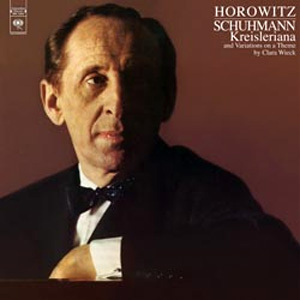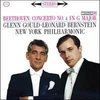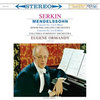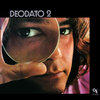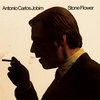AAA 100% Analogue This LP was Remastered using Pure Analogue Components Only from the Master Tapes through to the Cutting Head
Speakers Corner / Columbia MS 7264 - 180 Gram Virgin Vinyl - AAA 100% Analogue
Limited Edition - Pure Analogue Audiophile Mastering - Pressed at Pallas Germany
Speakers Corner 25 Years Pure Analogue This LP is an Entirely Analogue Production
Horowitz’s 1969 recording managed to bring a semblance of meaning and cohesion to Schumann’s manic-depressive self-portrait.- Sound 5/5 Audiobeat
As for the recording, it is beautiful. Speakers Corner is a German company that presses on 180 gram vinyl and to the highest audio standards. The presence of the piano here is very “live” and very “real” It sounds not like you are listening from the back of a hall but very close to Horowitz and the results are truly impressive. Speakers Corner has re-mastered a number of the old Columbia Masterworks recordings and I would welcome any of them that hold this level of historic performance and state of the art sound. It is a bonus that, in the high end vinyl market, their products are all reasonably priced, as well. Highly recommended! AudiophileAudition
All of these qualities can be heard on the original, but the new transfer brings added weight and power, and an even greater sense of presence. Indeed this is the finest piano sound I have heard from a CBS tape. It is also – one suspects – the finest example of the Horowitz sound available, and puts the Sony Classical Horowitz Edition to shame. Classical Source
Robert Schumann: Andantino from Sonata No. 3, Op. 14, Kreisleriana, Op. 16 - Vladimir Horowitz )
Pianist Vladimir Horowitz performs compositional works by Robert Schumann including Kreisleriana and Andantino from Sonata No. 3.
Robert Schumann's Kreisleriana, Op. 16 contains eight movements composed for solo piano written in 1838. The work is a dramatic work considered to be one of Schumann's finest and was dedicated to Frederic Chopin and also is a testament to his love for his wife Clara.
It is always tempting with the "Kreisleriana", a portrayal of E.T.A. Hoffmann's wild, eccentric and genial Kapellmeister Kreisler, to study both the literary figure and to try to identify the characteristics of the composer Robert Schumann himself. In the eight Fantasies, as Schumann called them, we find a romantically coloured reflection of the ups and downs of life, which an artist such as Vladimir Horowitz could empathize with. Right in the very first movement furious chains of triplets like electrical fire (Hoffmann) seem to leap out of the keyboard.
With a cool mind and extreme sensitivity Horowitz treats the extreme tempo markings such as 'very heartfelt, very agitated, very fast' with restrain, resulting in a haunting and controlled expression. The result is an effusion of gently flowing melodies and swift, pulsating movement full of spirited rhythm which heightens to nervous emotion. Rich, saturated sounds from the piano breathe life into even the quietest passages and the listener's highest expectations are totally fulfilled - as such a key work deserves.
It only takes a little imagination to conjure up something of the irony and humour of the romanticist when the music vibrates in the play of facial muscles of the Kapellmeister Kreisler.
The clarity of this all-Schumann studio album was easily superior to Horowitz’s live concert recordings. The microphone placements were neither too far nor too close, resulting in a superbly reproduced perspective on a solo piano. As with all their Columbia Masterwork re-releases, Speakers Corner made this record from the original analog master tapes. Masterdisk in New York cut the lacquer, Quality Record Pressings made the metal stampers, and Pallas in Germany did the final manufacturing. No digital processes interfered at any point in the chain. The end result is quality work; but for the absence of audience noise, it sounds live, and the LP was flat with perfect surfaces
Horowitz was born to play Schumann. His nervous temperament and edgy virtuosity lent themselves to Kreisleriana’s fiery passion and tender moments. Always a master of tempo, Horowitz felt at home with the music’s constantly shifting time signatures, his strong hands helped him play the big crescendos without banging, his pedal technique was never zealous, and he easily sustained notes without it. While he occasionally made mistakes (he always did), his audiences never cared. His performance did not have the every-note-is-a-unique-event quality of a pianist such as Michelangeli, but the music did not demand it. Horowitz’s 1969 recording managed to bring a semblance of meaning and cohesion to Schumann’s manic-depressive self-portrait. Sound 5/5 Audiobeat
Recording: February and December 1964 at Columbia's 30th Street Studio, New York, by Fred Plaut
Production: Richard Killough
Musicians:
Vladimir Horowitz, piano
Selections:
Selections:
Robert Schumann (1810-1856)
Side One:
1. Variations on a Theme by Clara Wieck (Third Movement--Andantino--from Sonata No.3 in F Minor, Op. 14)
2. Kreisleriana, Op.16 (Beginning)
I. Ausserst bewegt
II. Sehr innig und nicht zu rasch
Side Two:
1. Kreisleriana, Op. 16 (Conclusion)
III. Sehr aufgeregt
IV. Sehr langsam
V. Sehr lebhaft
VI. Sehr langsam
VII. Sehr rasch
VIII. Schnell und spielend
Recording: February and December 1964 at Columbia's 30th Street Studio, New York, by Fred Plaut
Production: Richard Killough

25 Years pure Analogue
This Speakers Corner LP was remastered using pure analogue components only, from the master tapes through to the cutting head 25 Years pure Analogue
Are your records completely analogue?
Yes! This we guarantee!
As a matter of principle, only analogue masters are used, and the necessary cutting delay is also analogue. All our cutting engineers use only Neumann cutting consoles, and these too are analogue. The only exception is where a recording has been made – either partly or entirely – using digital technology, but we do not have such items in our catalogue at the present time
Are your records cut from the original masters?
In our re-releases it is our aim to faithfully reproduce the original intentions of the musicians and recording engineers which, however, could not be realised at the time due to technical limitations. Faithfulness to the original is our top priority, not the interpretation of the original: there is no such thing as a “Speakers Corner Sound”. Naturally, the best results are obtained when the original master is used. Therefore we always try to locate these and use them for cutting. Should this not be possible, – because the original tape is defective or has disappeared, for example – we do accept a first-generation copy. But this remains an absolute exception for us.
Who cuts the records?
In order to obtain the most faithful reproduction of the original, we have the lacquers cut on the spot, by engineers who, on the whole, have been dealing with such tapes for many years. Some are even cut by the very same engineer who cut the original lacquers of the first release. Over the years the following engineers have been and still are working for us: Tony Hawkins, Willem Makkee, Kevin Gray, Maarten de Boer, Scott Hull, and Ray Staff, to name but a few.
At the beginning of the ‘90s, in the early days of audiophile vinyl re-releases, the reissue policy was fairly straightforward. Companies such as DCC Compact Classics, Mobile Fidelity, Classic Records and others, including of course Speakers Corner, all maintained a mutual, unwritten code of ethics: we would manufacture records sourced only from analogue tapes.
Vinyl’s newfound popularity has led many other companies to jump on the bandwagon in the hope of securing a corner of the market. Very often they are not so ethical and use every imaginable source from which to master: CDs, LPs, digital files and even MP3s.
Even some who do use an analogue tape source employ a digital delay line, a misguided ’80s and ‘90s digital technology that replaces the analogue preview head originally used to “tell” the cutter head in advance what was about to happen musically, so it could adjust the groove “pitch” (the distance between the grooves) to make room for wide dynamic swings and large low frequency excursions. Over time analogue preview heads became more rare and thus expensive.
So while the low bit rate (less resolution than a 16 bit CD) digital delay line is less expensive and easier to use than an analogue “preview head”, its use, ironically, results in lacquers cut from the low bit rate digital signal instead of from the analogue source!
Speakers Corner wishes to make clear that it produces lacquers using only original master tapes and an entirely analogue cutting system. New metal stampers used to press records are produced from that lacquer. The only exceptions are when existing metal parts are superior to new ones that might be cut, which includes our release of “Elvis is Back”, which was cut by Stan Ricker or several titles from our Philips Classics series, where were cut in the 1990s using original master tapes by Willem Makkee at the Emil Berliner Studios. In those cases we used only the original “mother” to produce new stampers.
In addition, we admit to having one digital recording in our catalogue: Alan Parsons’ “Eye in the Sky”, which was recorded digitally but mixed to analogue tape that we used to cut lacquers.
In closing, we want to insure our loyal customers that, with but a few exceptions as noted, our releases are “AAA”— analogue tape, an all analogue cutting system, and newly cut lacquers.
60 Years Pallas
Audiophile Vinyl - Made in Germany For over 60 years the family business in the third generation of the special personal service and quality "Made by Pallas" is known worldwide. Our custom PVC formulation produces consistently high pressing quality with the lowest surface noise in the industry. Our PVC complies with 2015 European environmental standards and does not contain toxic materials such as Lead, Cadmium or Toluene. Our vinyl is both audiophile and eco-grade!
